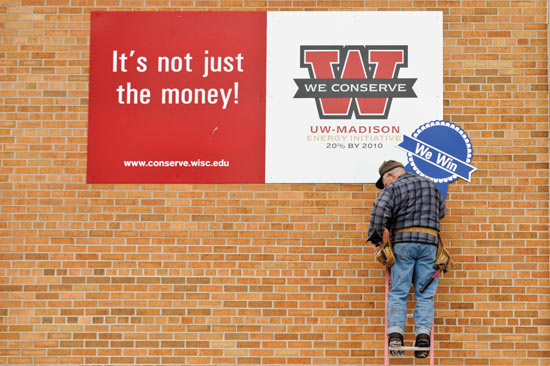UW-Madison conservation goals heeded and exceeded

Brian Klock, a carpenter in Facilities, Planning and Management, installs a blue ribbon with the words “We Win” on a We Conserve sign located on Engineering Hall. The blue ribbons, which Klock placed on all We Conserve signs across campus, mark the success of the environmental stewardship program, which exceeded a 2006 goal of reducing campus energy use by 20 percent by 2010.
Photo: Bryce Richter
In a season traditionally devoted to reflection and new beginnings, a campus program is celebrating its successes and looking ahead to new goals.
We Conserve, an environmental stewardship program at the University of Wisconsin–Madison, pledged in 2006 to reduce campus energy use and environmental footprint by 20 percent by 2010. Program director Faramarz Vakili announced this week that the program exceeded this goal, achieving a 25 percent annual energy reduction relative to 2006 levels.
When the program launched in April 2006, the resolution was met with skepticism, Vakili says. After all, the university had just completed a five-year, $29 million investment to install numerous energy-saving measures to improve the efficiency of lights, motors, and other “low-hanging fruit.”
We Conserve tackled larger projects, including updates in heating and cooling systems — by far the single largest energy consumer on campus — and lighting upgrades in buildings and parking ramps. Many of the gains were achieved through major retro-commissioning of older buildings including Engineering Hall, Chamberlin Hall and the Chemistry Building.
The reductions and savings achieved by We Conserve include:
- energy use: 1.2 trillion BTUs annually
- carbon dioxide emissions: 125,000 metric tons annually
- water use: 178,000,000 gallons annually
- diesel fuel: 10,000 gallons annually
- utility costs: $13 million annually
The upgrades cost approximately $40 million, an investment with an expected payback of less than five years, Vakili says. Staff from Facilities, Planning and Management noted the achievements this week by posting celebratory blue ribbons on the large red We Conserve signs found on more than a dozen campus buildings.
As campus director of sustainability operations, Vakili emphasizes that the accomplishments to date are just the beginning. The program’s second main goal was to increase awareness and instill a spirit of environmental stewardship in the campus community — an area Vakili admits is more challenging to gauge.
“We really have to think about what we’re trying to accomplish,” he says. “It’s one thing to strive for energy efficiency, and I believe we are doing that successfully. But to go beyond that, we need to truly engage people.”
Toward that end, We Conserve will continue as part of the Campus Sustainability Initiative. However, the program emphasis is shifting toward community engagement with “Be the We,” a campaign that aims to unite new and existing programs and celebrate conservation and waste prevention successes from across campus.
“With ‘Be the We,’ our goal is to go beyond efficient buildings and systems, and help people understand that conservation and sustainability is a state of mind,” Vakili says. “It’s possible to live a life in the future that is smart, efficient, sustainable and comfortable.”



